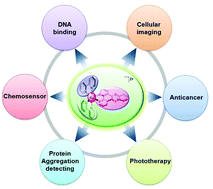Ruthenium(ii) complexes with dppz: from molecular photoswitch to biological applications
Abstract
The DNA photoswitch [Ru(bpy)2dppz]2+ (bpy = 2,2′-bipyridine, dppz = dipyrido[3,2-a:2′,3′-c]phenazine) has attracted much attention and become a powerful tool for studying the interaction of metal polypyridyl complexes with DNA. A large number of Ru-dppz complexes have been designed for a wide range of uses in many fields. In this perspective, we first introduce the latest results of Ru-dppz complexes that bind with DNA. The mechanisms of the light-switch effect and the structural modifications of Ru-dppz systems are also briefly introduced. We also review the recent advances in biological applications of the Ru-dppz system in DNA binders, cellular imaging, anticancer drugs, protein aggregation detection and chemosensors.



 Please wait while we load your content...
Please wait while we load your content...